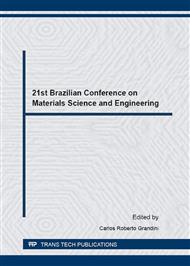p.913
p.918
p.924
p.930
p.935
p.940
p.946
p.952
p.957
Mechanical and Microstructural Characterization of the Ti-25Ta-25Nb Alloy for Dental Applications
Abstract:
Titanium and its alloys have been used in biomedical applications due to their excellent properties such as high corrosion resistance, biocompatibility and mechanical properties. In orthodontics, initially, it was common to use nickel-titanium alloys, however due to allergic reactions of patients, new titanium alloys containing elements such as niobium and tantalum are being studied. The Ti-25Ta-25Nb alloy is a β-titanium alloy and it has a low elastic modulus. In the present work, the ternary alloy was evaluated after cold work by swaging followed by solubilization treatment. Microstructure and mechanical properties were evaluated after each step of the process. Results were similar to find in the literature for this alloy obtained by other processing rote.
Info:
Periodical:
Pages:
935-939
Citation:
Online since:
August 2016
Keywords:
Price:
Сopyright:
© 2016 Trans Tech Publications Ltd. All Rights Reserved
Share:
Citation:


